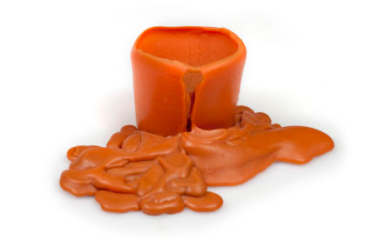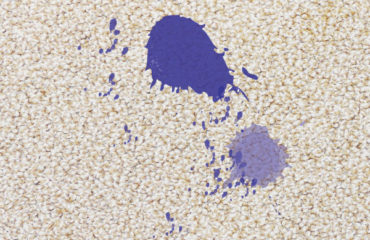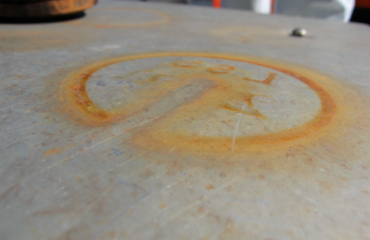Stain removal techniques only the experts use!
By Aaron Ovad, DryMaster founder and the industry trainer and consultant.
We’ve all been there. The job is done, the carpet looks fantastic and the customer is smiling as she writes out the check or hands over a credit card. As you wrap up the final aspects of the job, your customer looks closely at the carpet and says those dreaded words: “What’s this right here?”
 You go over, and sure enough, there’s a “spot” that you missed. You have options. Grab a spotter and towel and hope it easily comes out, or drag hoses back in and re-clean the area.
You go over, and sure enough, there’s a “spot” that you missed. You have options. Grab a spotter and towel and hope it easily comes out, or drag hoses back in and re-clean the area.As long as that spot comes out, you are good to go, although now you will be a little late for the next appointment.
But then…
After grabbing that spotter and towel and getting nowhere, you drag equipment back into the home and restart your machine. You then try everything in your spotting kit, even resorting to a few tricks you learned on an industry bulletin board.
The spot doesn’t come out. So you give it a new name for your customer. It is now called a “stain.”The customer is confused. All the other spots came out!
You explain that a spot is different from a stain. A spot is on the outside of the fiber, while a stain is inside the fiber, much more difficult — and sometimes impossible — to remove.
No matter how much explanation you offer, the customer seems confused. As you keep talking, her eyes glaze over and she starts to sway. You realize you have lost this battle.
You lick your wounds — but still accept payment for the job — and realize you may not get that stellar referral you were hoping for.
Off you go to your next job and, adding insult to injury, you’re about an hour late.
Setting expectations
Before cleaning commences, it’s always a good idea to inspect the job and set reasonable expectations for the customer.
If you do this, you will have an easier task of explaining that not all spots and stains come out, but that you will do your best to remove them.
You want to build confidence in your customer that she has chosen the best, but you also want to be honest. There are some staining materials, such as mustard, coffee, artificial colors in beverages, etc., that if not removed immediately, can be very difficult to remove, if not impossible.
At least we all know that using the principles of cleaning (chemicals, heat, agitation and time) will remove most spots during regular cleaning.
But it only takes a small stain or two remaining to ruin the entire job.
Stain ID
The first step to becoming more technically proficient as a stain removal technician is with identification.
If you can identify the staining substance, you can then set expectations with your customer, and when you begin cleaning, you can better choose the proper chemistry and cleaning technique.
For example, how much contact time should your cleaning chemical have with a stain? It depends on the stain. For example, reducing agents usually work much faster visually than oxidizing agents. So if you determine you need an oxidizer for a particular stain, you might apply that product to the stain and allow it more contact time while you work on something else in the home, such as another room. Many cleaning technicians choose to use reducing or oxidizing agents, which are bleaching agents, as a last resort.
A good rule of thumb with stain identification is if it looks “earthy” or somewhat dull, it’s probably an organic stain, such as coffee, tea, red wine and most foods. If the stain looks “shiny” or bright, it’s probably a synthetic stain, such as Kool-Aid, artificial colors, cosmetics or medications. Don’t forget the use of the word “probably” in this article because this isn’t an exact science.
The location of the stain can help with identification. If it’s in a dining room, it’s probably food related. If it’s near an entryway, maybe it’s from foot traffic, which can be just about anything. If it’s in a bedroom, perhaps it’s a cosmetic or some kind of medication. If it’s in the living room, it can be anything.
Of course, there’s a slight chance the customer will know what caused the stain. It doesn’t hurt to ask.
Trouble on the horizon
The first consideration to have in mind is if the customer tried their own stain removal skills before you arrived; that just adds to the difficulty of the job.
Consumer products are not as effective as professional products. That’s the first problem.
The second problem is most consumers don’t know how to use them.
The third problem is they use too much product. If a little doesn’t do the job, use more. If that doesn’t work do it again.
The fourth problem is they don’t remove the existing spot, and — to add insult to injury — they don’t remove the chemical residues. These build up on the carpet and become a bigger problem.
All of this can create a very stubborn stain, one that the customer expects you to remove completely. After all, you are the pro, right? The carpet should look brand new, just like the day it was installed.
Can you see why you must prequalify the job?
Removing the stain
Once you have identified the stain, it’s now time to get to work.
We’re not going to cover techniques to remove “easy” spots, which would require an acid spotter, neutral spotter, protein spotter or dry solvent spotter. What we’ll concentrate on is what to do when regular cleaning techniques fail, and it is time to get ambitious.
Let’s back up about five paragraphs here and discuss how to use the two types of bleaches (oxidizers and reducers) on the two types of tough stains: Organic and synthetic.
Here is the typical disclaimer: You, as the cleaning pro, must identify the fiber and use products appropriately. Any damage is all yours, although that can be tempered with a signed release from your customer.
Organic stains
Organic stains are common — and tough. After attempting removal using typical methods — using common spotters — you need to get aggressive, with customer approval.
Get out your oxidizer.
Oxidizers are often found in either liquid or power form. Just follow the directions. If the product you are using is in two parts, that’s because one is the oxidizer, and the other is the accelerant (ammonia/alkalinity). There are plenty of one-part products on the market today that work efficiently. If using a powder, you can use it as-is or add a few drops of ammonia after mixing the oxidizer with water. Ammonia is the accelerant.
Basically, you will wet out the stain with your oxidizer, and let it have sufficient contact time. This might be 30 minutes or so. Some cleaning techs like to employ heat, such as from a clothes iron. But always put a damp towel between the stain and the clothes iron to protect the carpet surface. When using this technique, you might limit the contact time with the clothes iron to 15-30 seconds each application.
Contact time with oxidizers is very important. You might even leave the spot “wet” with an oxidizing solution for a day, covering up the area with plastic so it doesn’t dry out. This means you have to encourage cooperation with the homeowner. Final results aren’t seen until the area has dried.
An oxidizer is going to add oxygen to the stain, “burning away” the stain. Compare it to putting peroxide on an infected cut on your skin. Bubbling and burning the infection is basically what you are doing with the carpet stain.
Synthetic stains
Synthetic stains are becoming much more common, as many of the popular beverages used by consumers are colored with synthetic materials.
After attempting removal using typical methods — using common spotters — you need to get aggressive, with customer approval.
Get out your reducer.
Reducing agents are usually liquid. They are often two parts, although there are some effective one-part products on the market. The rare powdered version can be accelerated by using an acid product, such as vinegar or citric acid. Just a few drops in the mixture will be sufficient.
Mix your reducing agent according to directions, and wet out the stain. Using heat is important to get the quick reaction you desire. As was mentioned before, you can use a clothes iron, but be sure to protect the carpet surface with a damp towel.
A reducer is going to have the opposite reaction as an oxidizer, in that it strips away oxygen or removes oxygen from the stain, altering the color molecules, making the stain invisible.
Typically, you will see instant results when removing a synthetic stain with a reducing agent. If you don’t, odds are the stain is permanent, and you can move into more aggressive (but often not recommended) stain removal techniques using chlorine bleach, or you can section the carpet and replace the small area.
If you got this far…
…I’d like to give you a reward. I have a cool spot and stain removal guide that has tons of information you can use for your business. It’s especially useful for training your technicians. Just drop me an e-mail at [email protected] , and I’ll send it to you.
Aaron Ovad the founder of DryMaster and is an industry trainer and consultant. He can be reached via e-mail at [email protected].



